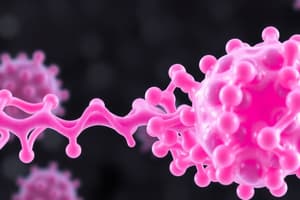Podcast
Questions and Answers
What is the primary function of apolipoprotein A-I?
What is the primary function of apolipoprotein A-I?
- Activates lipoprotein lipase
- Regulates uptake via the HDL receptor (correct)
- Facilitates the transport of chylomicrons
- Inhibits lecithin: cholesterol acyltransferase
Which apolipoprotein is specifically associated with the LDL receptor?
Which apolipoprotein is specifically associated with the LDL receptor?
- Apo A-I
- Apo C-II
- Apo B-100 (correct)
- Apo E
What characterizes the metabolism of very low-density lipoproteins (VLDL)?
What characterizes the metabolism of very low-density lipoproteins (VLDL)?
- They mainly transport dietary lipids
- They have a half-life of about 1 hour
- They are synthesized in the intestine
- They contain 10% protein including apo B-100 (correct)
Which of the following components is NOT a characteristic of chylomicrons?
Which of the following components is NOT a characteristic of chylomicrons?
What is the primary result of lipoprotein lipase (LPL) action on IDL?
What is the primary result of lipoprotein lipase (LPL) action on IDL?
What portion of lipoproteins is predominantly made up of protein?
What portion of lipoproteins is predominantly made up of protein?
Which lipoprotein type typically contains the most triacylglycerol (TAG)?
Which lipoprotein type typically contains the most triacylglycerol (TAG)?
Which of the following lipoproteins is primarily synthesized in the liver and competes with plasminogen?
Which of the following lipoproteins is primarily synthesized in the liver and competes with plasminogen?
What percentage of total plasma lipids does cholesterol typically account for?
What percentage of total plasma lipids does cholesterol typically account for?
Which lipoprotein has the lowest density due to its high lipid content?
Which lipoprotein has the lowest density due to its high lipid content?
Which of the following statements about apolipoproteins is correct?
Which of the following statements about apolipoproteins is correct?
Which method is NOT used to separate lipoproteins?
Which method is NOT used to separate lipoproteins?
Flashcards
Apolipoprotein
Apolipoprotein
A protein component of lipoproteins that helps them interact with receptors on cells, enabling the uptake of lipids into tissues.
Chylomicron
Chylomicron
A type of lipoprotein that transports dietary lipids (mainly triglycerides) from the intestines to the liver and other tissues.
Lipoprotein lipase (LpL)
Lipoprotein lipase (LpL)
An enzyme that breaks down triglycerides in chylomicrons and VLDL, releasing fatty acids for energy.
Very low-density lipoprotein (VLDL)
Very low-density lipoprotein (VLDL)
Signup and view all the flashcards
Intermediate density lipoprotein (IDL)
Intermediate density lipoprotein (IDL)
Signup and view all the flashcards
Why are lipids packaged with proteins?
Why are lipids packaged with proteins?
Signup and view all the flashcards
What are lipoproteins?
What are lipoproteins?
Signup and view all the flashcards
What are apolipoproteins?
What are apolipoproteins?
Signup and view all the flashcards
How is lipoprotein density determined?
How is lipoprotein density determined?
Signup and view all the flashcards
What are chylomicrons?
What are chylomicrons?
Signup and view all the flashcards
What are VLDLs?
What are VLDLs?
Signup and view all the flashcards
What are LDLs?
What are LDLs?
Signup and view all the flashcards
What are HDLs?
What are HDLs?
Signup and view all the flashcards
Study Notes
Lipid Transport
- Lipids are insoluble in water, thus associated with proteins to form lipoproteins, which are water-soluble.
- The protein component of lipoproteins is called apolipoprotein.
- Lipoproteins facilitate lipid transport between tissues.
- Total plasma lipids range from 400-600 mg/dL, comprising triacylglycerol (20%), phospholipids (30%), cholesterol (40%), and free fatty acids.
Lipoprotein Structure
- Lipoproteins consist of a lipid core (triacylglycerol and cholesterol esters) and a protein shell (apolipoproteins).
- Apolipoproteins are categorized as integral or peripheral. The percentages vary from 1% (chylomicrons) to 60% (some HDLs).
Lipoprotein Classification
- Lipoprotein density increases with the protein component.
- Lipoproteins are classified using ultracentrifugation and electrophoresis.
- Chylomicrons
- Very-low-density lipoproteins (VLDL)
- Intermediate-density lipoproteins (IDL)
- Low-density lipoproteins (LDL)
- High-density lipoproteins (HDL)
- Lipoprotein (a) (Lp(a)): similar lipid composition to LDL, but also competing with plasminogen to tissue plasminogen receptors.
- The predominant lipid component varies among types. For example: Triacylglycerol (TAG) is predominant in chylomicrons and VLDL. Cholesterol is predominant in LDL, and phospholipids are abundant in HDL.
Apolipoproteins
- Apolipoproteins are the protein components of lipoproteins.
- Five major classes (A-E) are known.
- Apo B exists in two forms (apo B-100 and apo B-48). Apo B-100 is in LDL, while apo B-48 is in chylomicrons.
- Apo (a) is present in lipoprotein (a), with apo B-100 and has a high carbohydrate content.
- Apolipoproteins:
- Enhance lipid solubility in plasma.
- Maintain lipoprotein stability.
- Act as ligands for lipoprotein receptors, facilitating tissue uptake.
- Specific apolipoproteins bind to specific receptors (apo B-100 and apo E for LDL receptors, etc.).
Apolipoprotein Enzyme Activity
- Some apolipoproteins are enzyme activators:
- Apo C-II for lipoprotein lipase.
- Apo A-I for lecithin:cholesterol acyltransferase (LCAT).
- Some apolipoproteins are enzyme inhibitors:
- Apo A-II and apo C-III for lipoprotein lipase.
- Apo C-I for cholesteryl ester transfer protein.
Metabolism of Chylomicrons
- Site of synthesis: Intestinal mucosa.
- Function: Transport of dietary lipids to peripheral tissues.
- Structure: Mostly triacylglycerol (98%), proteins (1-2%, including apo B-48, apo E, and apo C-II).
- Half-life: Approximately 1 hour.
Metabolism of Very-Low-Density Lipoproteins (VLDL)
- Site of synthesis: Liver.
- Function: Transport of endogenously synthesized lipids to peripheral tissues.
- Structure: Mostly triacylglycerol, proteins (10%, including apo B-100, apo E, and apo C-II).
- Half-life: 1-3 hours.
Formation of Intermediate-Density Lipoproteins (IDL)
- The action of lipoprotein lipase results in the loss of 70-90% of triacylglycerol and apo C.
- This leads to VLDL remnants, which are called IDL (intermediate-density lipoproteins).
- IDL has less triacylglycerol and more cholesterol.
- IDL is either: taken up by liver cells via LDL receptors, or converted to LDL.
Studying That Suits You
Use AI to generate personalized quizzes and flashcards to suit your learning preferences.




